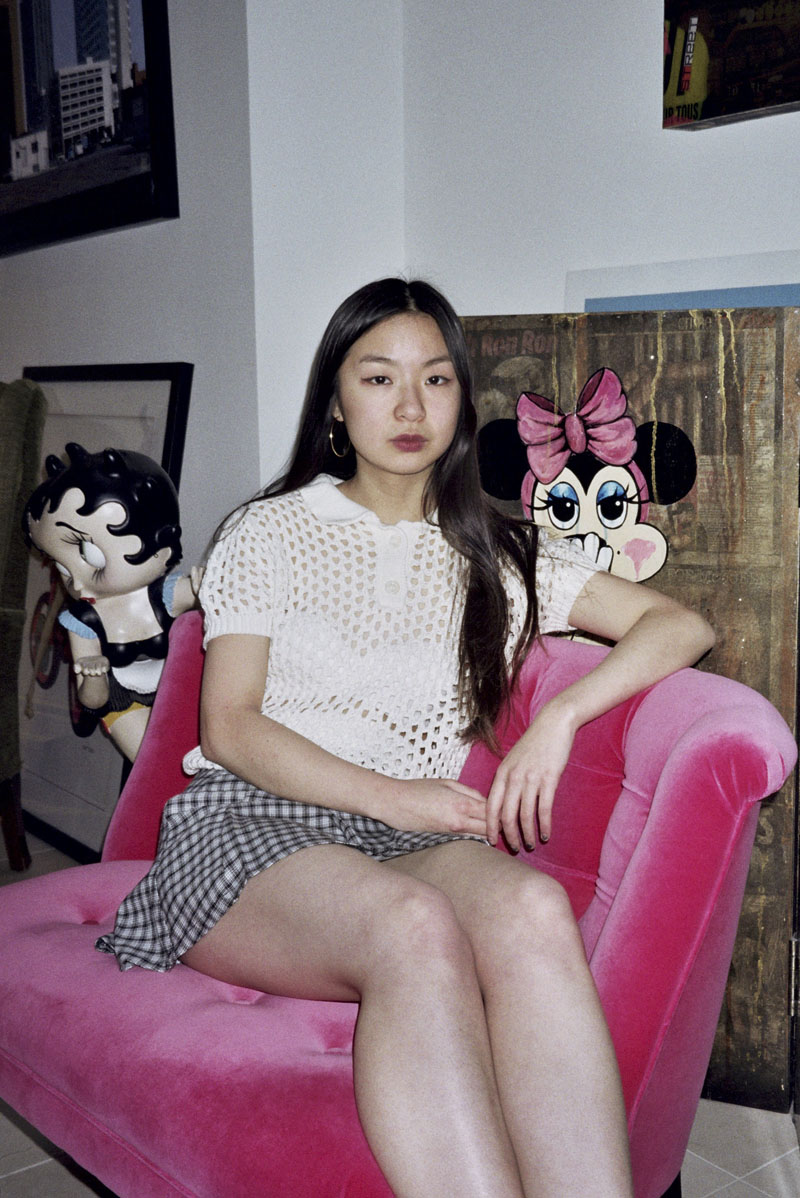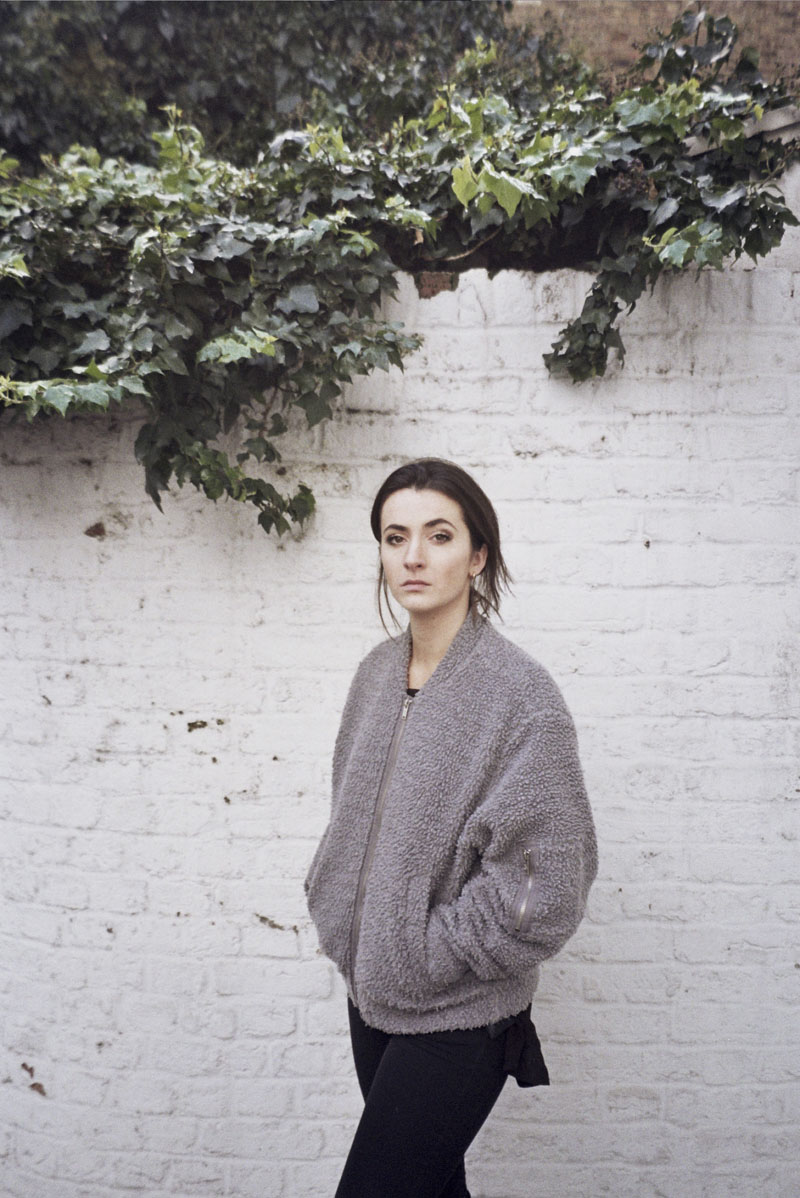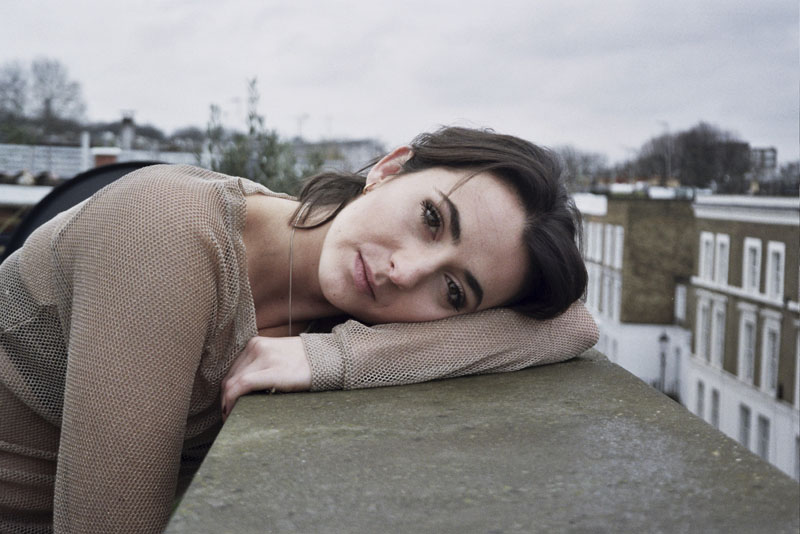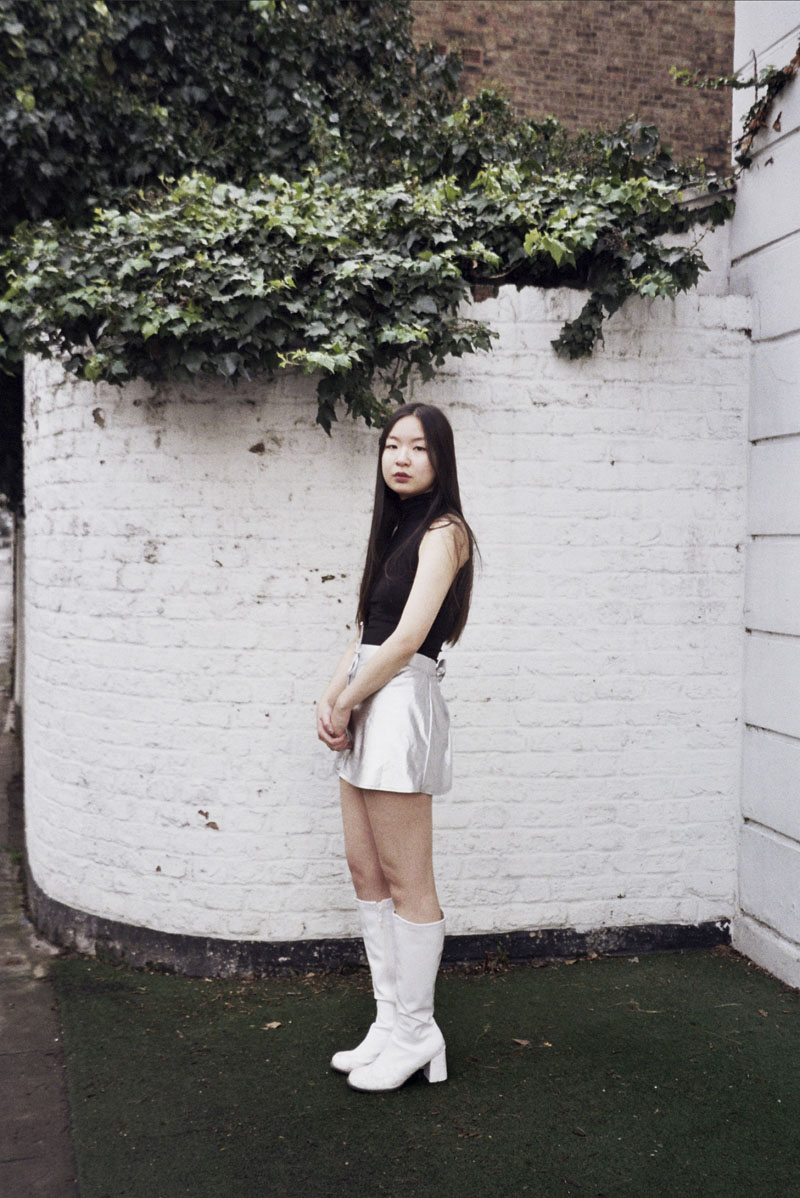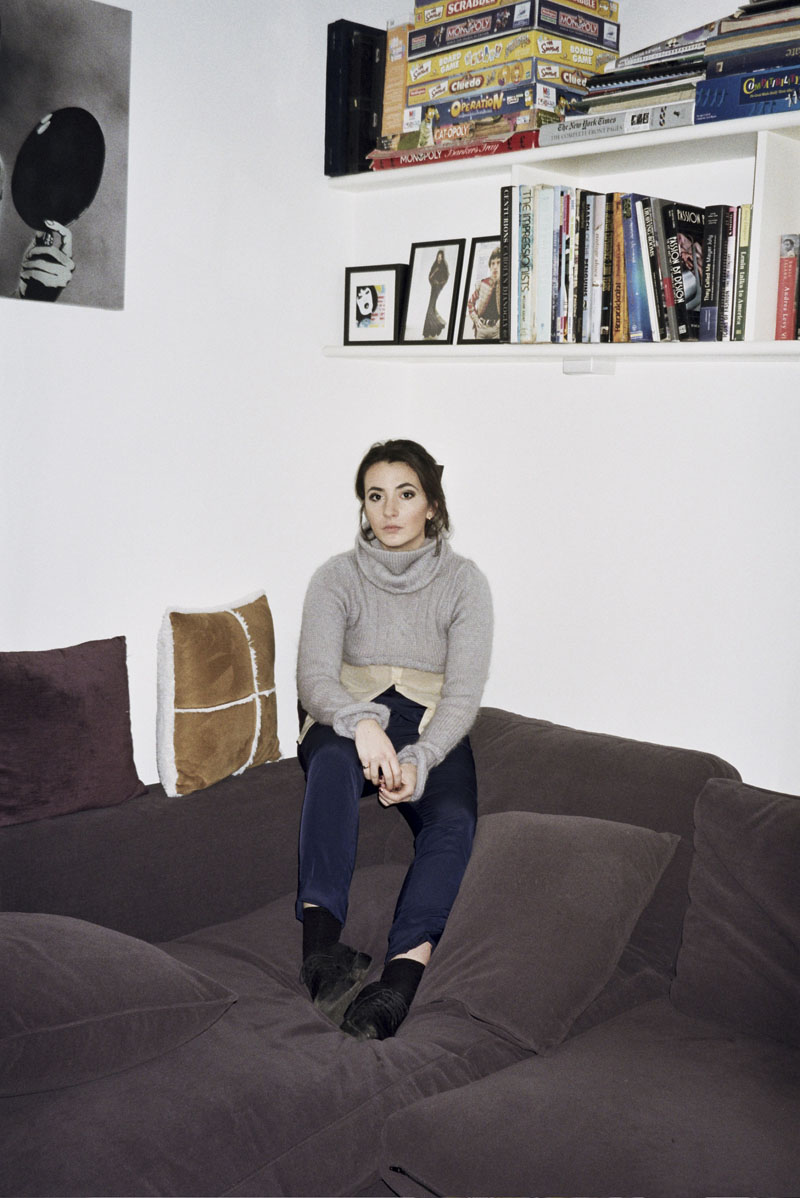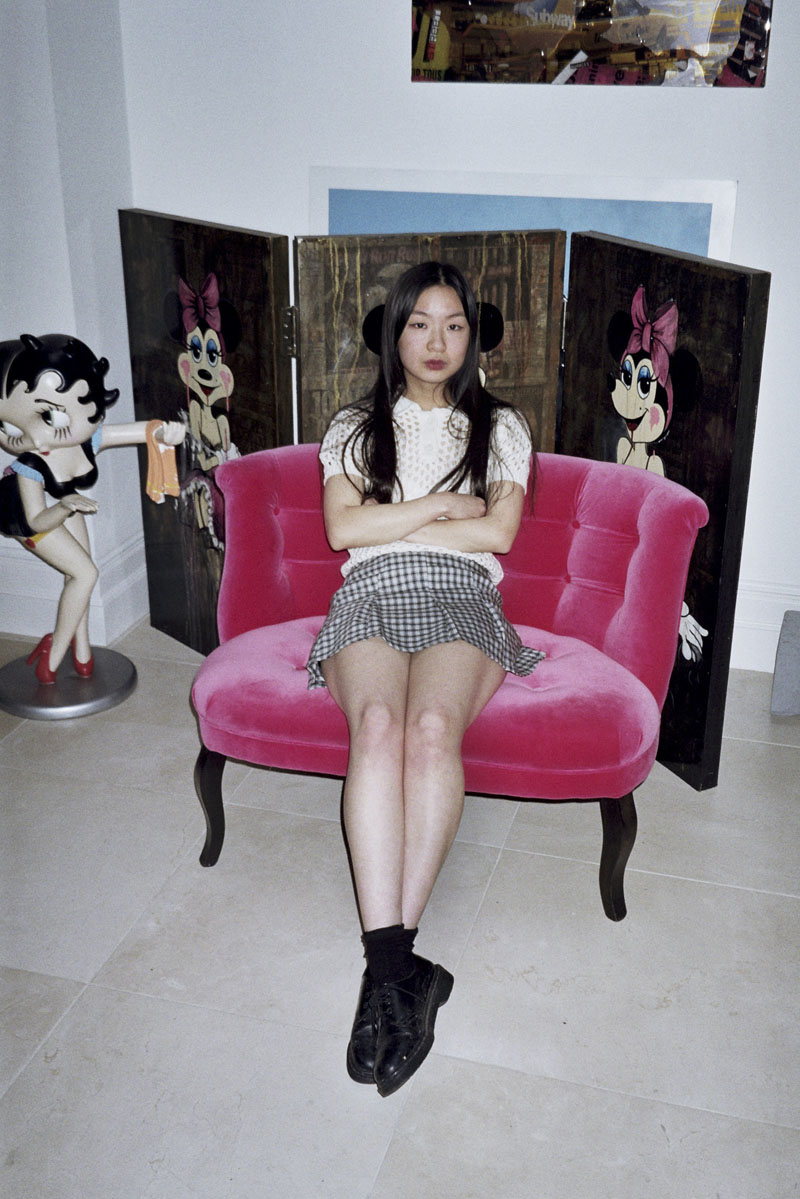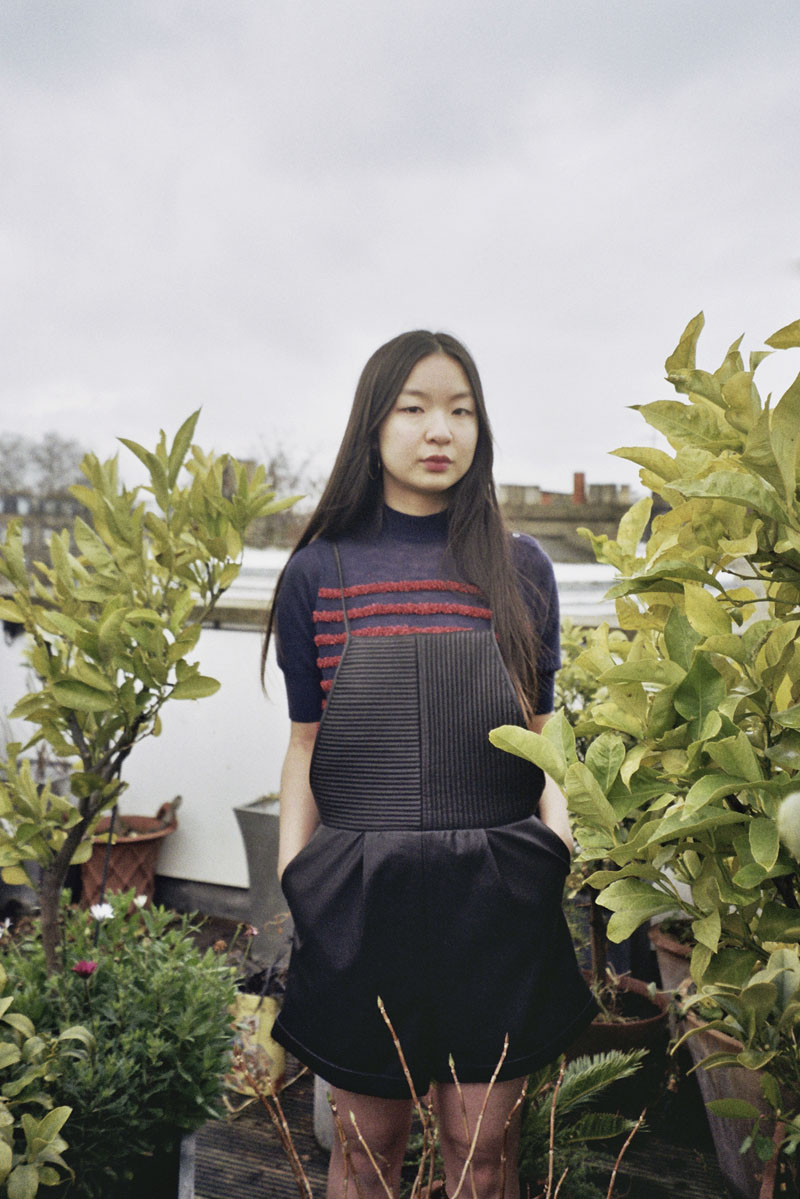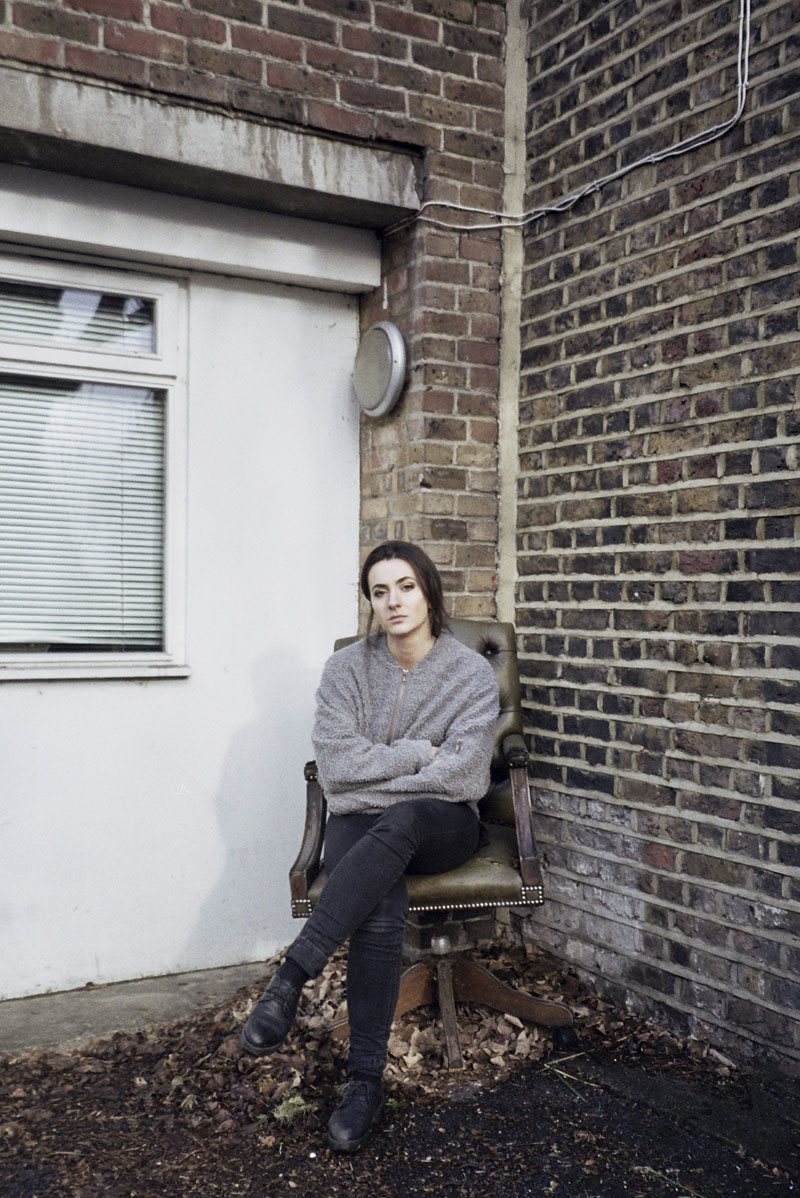Writer, Kate Eringer, sits down with three young, female artists, Tabitha Steinberg, Naomi Wong and Sarah Finney, who study and work in London, to talk contemporary art, ideas of being a female artist today, and inspiration. Photographer Rosaline Shahnavaz shoots them in Tabitha’s home. Styling done by Alexandra Unterhalter and Kate Eringer.
![31A_0175]() from left: Sarah Finney (20) studies at Chelsea College of the Arts, Tabitha Steinberg (22) studies at The Art Academy
from left: Sarah Finney (20) studies at Chelsea College of the Arts, Tabitha Steinberg (22) studies at The Art Academy
and Naomi Wong (20) studies at Kingston University – photographed by Rosaline Shahnavaz
How do you see ‘Contemporary Art’ now – what does it mean to you?
Tabitha – For me, it is a very chaotic and volatile thing. Being such a huge and broad entity, I find myself imagining Contemporary Art as a thick mass of stuff that you must wade through to find a hidden gem. There’s a lot of shit. But of course, shit is an inescapable by-product of something else amazing. I think more than ever, people are beginning to address the formaldehyde elephant in the room and search for new integrity and intention to something that has spiraled (as most things do) into a controlled, money-driven business. Over the bulldozing roar of the auction house, you can still hear the whimper of great work.
Sarah – I feel that the people that account for the contemporary art scene, curators, dealers, museum directors, artists, etc., for the past ten or fifteen years have been pushing forward having younger names in their agenda, using the art market as a starting point for relationships to art making and the work of younger artists. I feel that the support of successful critics and curators towards younger artists, who do not necessarily have fully developed bodies of work, creates new opportunities for contemporary art and allows more experimentation.
Your art is by definition contemporary, but do you view yourself as a contemporary artist?
Tabitha- That’s an interesting idea of separation between an artwork and its artist – does it necessarily follow that if your art, by definition, is contemporary, you in turn must be a contemporary artist? I suppose in light of such works as Death of the Author, no. Or I guess, more precisely, the question becomes irrelevant. It seems the less bound we are to labelling ourselves to reflect our own artwork, the less restrictions we place on our art to be something predesigned inline with a public image.
Sarah- I do consider myself a contemporary artist because I work in the contemporary world, within a contemporary mindset. At the same time my practice is based within a digital context in which I work with technologies that might have been around for decades but that are now more accessible and available for the general population.
![Autosave-File vom d-lab2/3 der AgfaPhoto GmbH]() Tabitha Steinberg
Tabitha Steinberg
Where do you gain inspiration?
T- Well, currently, notorious website artrank.com is telling me to stock up on my Aaron Garber-Maikovskas, which of course for an artist means: steal this guy’s ideas. Unfortunately, by the time this article is published, he’ll have been relegated from the ‘BUY NOW < $100,000’ column to the terrifying ‘LIQUIDATE’ column. But more seriously and less cynically, being inspired by other’s work is very important to my own. I can’t imagine an artwork that stands uninfluenced and untainted by all that has come before. The work of Frank Auerbach (which I will credit my A-Level art teacher with introducing me to) and Francis Bacon’s 2008 exhibition really expanded my understanding of what drawing and painting can be and led me to artists like David Bomberg and Dora Carrington. Equally, the writings of Gogol were a huge eye-opener to me, in terms of experimentation, playfulness and pure strangeness of what a masterpiece can be. I am still dumbstruck by Sigmar Polke’s retrospective at the Tate Modern – it has really shook me!
S- Usually my inspirations come from translating what’s around me, from personal experiences to simple things I like. I get these inspirations mostly through video and film editing; there are things within the digital that are new disciplines that I do not fully understand, thus making my process quite performative in a very psychological sense. In my work I question certain concepts in science that I don’t fully understand. The inspiration for my work comes from some sort of ironical play between my own naïveté and the things that I can actually make sense of. For me, to live in a society where most of the people live half of the day inside a virtual world, which they most likely do not know how it physically works, fully draws my attention. It is like living on the edge of something unknown.
Naomi – I take inspiration mainly from films, my own personal experiences and the work of other photographers and artists. Sometimes its bad to look at the work of others because you put yourself down comparing yourself to them but I guess that’s just what creative people do. I remind myself that everyone is different and it takes a certain amount of time for people to develop a way of working or the sense of style within their work. I also like looking at photo books, blogs and old copies of national geographic I used to steal from school. Obviously I won’t be taking pictures in the Amazon or going around the Antarctic Circle anytime soon but the images in the magazine are always so powerful and make me want to keep taking pictures!
![Autosave-File vom d-lab2/3 der AgfaPhoto GmbH]() Naomi Wong
Naomi Wong
What do you try to capture with your work? Is there a particular meaning or message that inspires you while you work that might aid the viewers’ appreciation?
T- The word ‘capture’ stands out to me. Capture implies something still or perhaps something that you want to make still. This is often how a piece of art is seen. For example, we may speak of an artist’s ability to masterfully capture and make permanent a fleeting gesture of someone in their portrait. Of course, we love to be able to find permanence in something that can disappear in an instant. It is comforting. This is partly what my artwork deconstructs and tries to unfold. In regards to aiding a viewer, I do not feel a viewer needs to be aided. I’m not seeking to impress upon someone or expand an ignorant viewer’s mind. The viewer expands the art.
N- With my personal work, I try to capture moments that have affected me in some way and the people in my life who mean a lot to me. I take pictures for myself; its very important for me to capture what’s going on in the moment so I can look back one day and remember certain things I might have otherwise forgotten about. My editorial work, which is made up mainly of fashion portraiture, is something I have fun with and experiment, it’s also a way for me to meet collaborators to work with.
What do you think of London being an artistic epicenter?
T- I’m all for it! I do feel very lucky that I am exposed to so much creativity in my city. A lot of what’s going on is in Berlin and New York but there is a curious uniqueness to the London art world. It keeps on goin’. It doesn’t take itself too seriously.
S- I think London and various European cities have become art epicenters since more than any other continent, Europe has had a long tradition within the public arts funding. Also the fact that lots of artists from around the world come to this city to root their practice makes it a much more accessible space for the arts. At the same time there are certain financial problems that might slow the processes of art students, which is quite paradoxical since we live in a city that has massive amounts of culture to offer but at the same time is the most expensive city in the world, which can really complicate things for young artists who are trying to make a name and don’t have the means to let’s say, pay their rent.
![Autosave-File vom d-lab2/3 der AgfaPhoto GmbH]() Sarah Finney
Sarah Finney
What are your thoughts on ‘youth’ as artists?
S- I strongly believe that contemporary art accounts more towards the development of a procedural thinking and the conceptualizing of universal ideas presented to us by art theorists, critics or philosophers, thus to create a personal language that relates to the current situation of art. The idea that the use of certain new technologies or aesthetic statements such as minimalism has no craftsmanship in them is wrong.
What are your thoughts on the ‘YBA’ movement – how did that effect art in the UK/world? How did it affect the publics’ view on contemporary art?
T- My first interaction with anything YBA was at the age of 6. It wasn’t in an art gallery – it was in Pharmacy, the concept restaurant backed by Damien Hirst. This in itself says a lot. The YBAs really did become businessmen and women – and unashamedly! I think what happened in the 90s has definitely rippled into the present day in terms of negative opinions of contemporary art. But of course this isn’t unfounded. Art has become a self-deprecating commodity laughing in its own face. Farcical and sad. And Hirst can’t even make good fries.
S- The YBA movement is important because it opened up a new platform for the arts education, pushing towards more conceptual thinking to be included in the classroom. I believe that supporting these artists made the whole notion of visiting galleries and museums more engaging, in relationship to the actual thinking that is supposed to happen when contemplating an artwork. Art now involves a wider range of viewers and participants.
Thoughts on being a woman in the art world
N- It has got better over the years but I still think female artists are under-represented within the art world. Lately there have been many supportive all girl collectives online, which I think is great and gives an even wider platform for female artists to collaborate and support each other wherever they are.
S- Within society the art world is a very inclusive place for females to develop. As Grayson Perry states in his last years Reith lectures, women earn more money within the art world than men, when at the same time in most Art Fairs around the world (such was the case of Miami Basel in 2014) around 80% to 90% of the artwork shown is made by men.
When talking about my practice I do not necessarily take into account the fact that I am a female. I never really understood what it meant for people to emphasize the act of being a female artist. I understand that there could be many implications and many can regard my work as a product of my gender. But I like to think of art as something universal that poses questions about gender, not that gender poses questions about the universal. My work may show reelections of feminity, but also of masculinity, and it should be judged on that, not the female who created it.
In reality I don’t know if my experience as an artist that is a woman would have been different if I’d been born a man. I have never been a man so I don’t really know.
What is Art to you?
N- I think its something that makes you think and feel.
What issues in todays’ world are on your mind and in your conversation?
N – The racial tension in America with what happened in Ferguson really bothered me last year and still does now, racism in general has been something I have been thinking about for a long time and is still a problem. I grew up with it and some of my friends don’t seem to understand why it bothers me, which can be quite upsetting at times.
What is next for you?
T- Apart from continuing to study my degree in Fine Art, I have an upcoming exhibition in Los Angeles in April and one in London in July. I am also participating in the New Artist Fair in March.
N- I have a few collaborations coming up and planning a few editorials for the next couple of months. I also have a photo book in the works with Young Shot Press, which I’m really excited about!
Sarah continues her Fine Art Degree at Chelsea College of the Arts.
& Photographer, Rosaline Shahnavaz, has a solo exhibition, Nothing in the World but You, at Notting Hill Arts Club in London each Friday and Saturday, from January 30th through until the end of February.
Photographer – Rosaline Shahnavaz- Instagram @rosaline_s - www.rosalineshahnavaz.com
Writer & Creative Director – Kate Eringer- Instagram @keringer - www.kate-eringer.com
Stylist – Alexandra Unterhalter & Kate Eringer
Artists – Tabitha Steinberg - www.tabithasteinberg.com
Naomi Wong – Instagram @naomiwongo - naomiwongo.tumblr.com
Sarah Finney- Instagram @esairviolet - vimeo.com/sevf94


